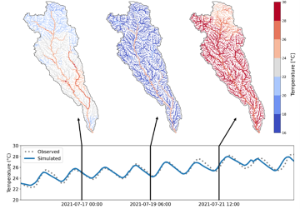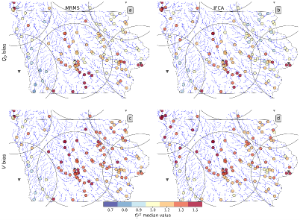

Climate is changing, and so are the drought oscillations. As part of Nicola’s research, the team has been exploring future drought conditions for Latin American Regions and their link with the El Niño Southern Oscillation (ENSO). The work involved projections using historical hydrological data, ENSO projections, and machine learning techniques. Using Random Forest ensembles corrected for bias, the study forecasts streamflow using CMIP6 projections. Drought was evaluated using SPI-12 and precipitation anomalies. Results indicate likely persistence of drought conditions in some of the watersheds of the region. The framework supports proactive water resource planning and highlights the influence of ENSO variability on regional water availability.
 Researchers developed a tool that predicts river temperatures on every element of the river network of a given region. By combining satellite imagery with local data, the model helps communities and scientists better protect fish and water quality as the climate changes. The tool is fast, accurate, and easy to use, making it valuable for planning and conservation efforts.
Researchers developed a tool that predicts river temperatures on every element of the river network of a given region. By combining satellite imagery with local data, the model helps communities and scientists better protect fish and water quality as the climate changes. The tool is fast, accurate, and easy to use, making it valuable for planning and conservation efforts.
 Radar quantitative precipitation estimates (QPE) are a key asset for flood forecasting as they provide information on the main forcing that triggers most of the major inland floods. However, QPEs have a relatively large uncertainty, often overlooked by the flood forecasters. The research has focused on understanding the uncertainty of radar composites and how it affects the forecasting performance. The results are promising, identifying spatial uncertainty patterns linked to the position of the radars and their local attributes. View a full description of work.
Radar quantitative precipitation estimates (QPE) are a key asset for flood forecasting as they provide information on the main forcing that triggers most of the major inland floods. However, QPEs have a relatively large uncertainty, often overlooked by the flood forecasters. The research has focused on understanding the uncertainty of radar composites and how it affects the forecasting performance. The results are promising, identifying spatial uncertainty patterns linked to the position of the radars and their local attributes. View a full description of work.
This research seeks to understand this impact by monitoring runoff nutrient production at the Florida Institute of Technology (FIT) campus and its Botanical Garden. This project proposes creating and implementing a low-cost, replicable environmental monitoring system at the Florida Institute of Technology (FIT) campus and Joy and Gordon Patterson Botanical Garden. The system will measure nitrate concentrations, rainfall, and soil moisture across urban, suburban, and natural landscapes. The aim is twofold: to quantify how different landscaping approaches affect nutrient runoff and to use these findings as a platform for public education and outreach. The monitoring system will be used as an educational tool for FIT students and for surrounding communities, including local public schools—through guided field trips, workshops, and hands-on activities.
© Florida Institute of Technology, All Rights Reserved